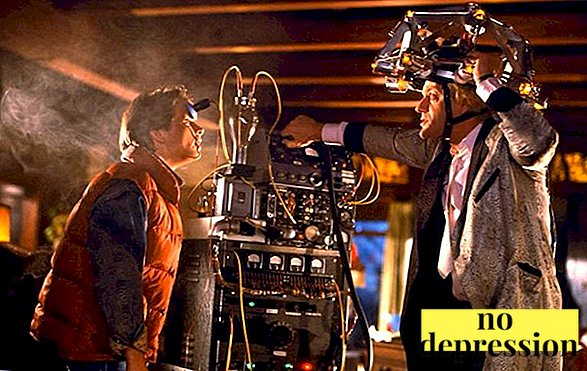When reality causes too many questions, discomfort increases in the brain. Or in a scientific way: cognitive dissonance arises. In order not to strain and restore harmony, the brain invents perception tricks: it blocks unprofitable information, finds the necessary evidence, calms, lulls. This property of our brain without a twinge of conscience is used by others. So knowledge of tricks will help not only to understand oneself better, but also to resist manipulation.
What is cognitive dissonance
Cognitive dissonance is a state of mental or psychological discomfort caused by a clash of conflicting ideas, actions, beliefs, emotions, or feelings. Occurs when a person receives unexpected information that is different from his past experience.. Or when one becomes a witness to unpredictable actions, unexplained events. The mechanism of cognitive dissonance is based on a simple but frequent situation: the presence of two mutually exclusive desires.
Dissonance is the opposite of the balance toward which our brains aspire. According to balance theory, people prefer harmony and consistency in their knowledge of the world. It is difficult for the psyche to be in a state of disturbing inconsistency. Therefore, in order to reduce the psychological discomfort of an internal conflict, a person changes his mind, comes up with an excuse for changing, and later changes his behavior. So he maintains his mental balance.
The paradox is that the more a person defends his behavior, the more willing to change his beliefs as circumstances change. For example, in moments of danger, after disasters, atheists become earnest believers. The saying "there are no atheists in the trenches" is just about that. What else? Implacable macho women misogynists after marriage become caring husbands, and patriots, after emigrating to another country, actively cease to love their former neighbors.
How our brain reduces discomfort in cognitive dissonance
Suppose you smoke and get information about the dangers of smoking. There are 4 ways to maintain balance.
- Change behavior: "I quit smoking in order to preserve my health and my loved ones."
- Justify your habit, add new facts: "I will smoke fewer cigarettes or replace them with less harmful ones."
- Change self-esteem or the importance of deciding: "If I stop smoking, I will recover (I will become angry). This will make my family and me even worse."
- Ignore data that contradicts beliefs: "I know smokers who have lived to 90 years. So cigarettes are not so bad."
These mechanisms help not only to avoid internal stress, but also to avoid interpersonal complications. For example, we complain about strangers to strangers, thereby relieving internal stress. Doing bad, looking for allies. We come up with excuses for betrayal of spouses, do not notice the ugly actions of children. Or vice versa - we underestimate the career achievements of competitors, explaining them as banal luck, hypocrisy, blat.
Theory of cognitive dissonance and its evidence
The definition of cognitive dissonance is one of the basic concepts in psychology. The author of the theory and many experiments was the American psychologist Leon Festinger (1919-1989). He formulated the definition and two main hypotheses:
- Hypothesis 1: mental discomfort, tested by a person in a certain situation, will motivate him to avoid similar situations in the future.
- Hypothesis 2: a person experiencing psychological discomfort by any means will seek to reduce mental discomfort.
According to the author of the theory, the causes of cognitive dissonance can be logically incompatible things, cultural customs, opposition of one person’s opinion to public opinion and painful past experience. That is, the proverb "burned with milk, blowing on water" just describes a person’s unwillingness to repeat a negative or painful past experience.
The theory of Leon Festinger is confirmed by experiments and studies of brain activity conducted on a tomograph. During the experiment, the subject was provided with the conditions for the simplest cognitive dissonance (they showed a red leaf and called a different color) and scanned brain activity on the tomograph. The tomography results showed that during an internal conflict, the cingular cortex of the brain is activated, which is responsible for monitoring certain activities, identifying errors, monitoring conflicts, switching attention. Then the experimental conditions became more complicated, the subject was given more and more contradictory tasks. Research has shown that the less excuse the subject finds for his action, the more he experiences stress, the more excited this area of the brain.
Cognitive dissonance: life examples
Cognitive dissonance occurs every time there is a need to make a choice or express an opinion. That is the dissonance is the ordinary, every minute phenomenon. Any solutions: to drink tea or coffee in the morning, choose products of one or another brand in the store, get married to a worthy applicant, will provoke discomfort. The degree of inconvenience depends on the importance of its components for a person. The higher the significance, the stronger the person seeks to neutralize dissonance.
For example, the most painful cognitive dissonance occurs then, when someone gets into a different cultural environment. For example, in women who left with a Muslim husband in his homeland. Differences in mentality, clothing, behavior, cuisine, traditions from the very beginning cause severe discomfort. To reduce tensions, women have to change perceptions of their own traditions and adopt new rules of the game dictated by local society.
Knowing this feature of the human psyche, politicians, spiritual leaders, advertisers, sellers use it for manipulations. How it works? Cognitive dissonance causes not only discomfort, but also strong emotions. And emotions are motivators that force a person to perform a certain act: buy, vote, join an organization, donate. Therefore, social agents from our environment constantly provoke cognitive dissonance in our brain in order to influence our opinion and behavior.
The most illustrative examples can be seen in advertising:
- Buy our product, because you deserve it.
- Loving parents buy their children chocolate / water / toys / sour cream of our brand.
- The real leaders have already subscribed to our channel / read a new book.
- Good housewives use our floor / stove / glass cleaner.
- This book is a real bestseller, haven't you read it yet?
So, the dissonance happened. The brain is boiling from tension and is looking for ways to reduce discomfort, get out of this situation, plunge into a state of calm. If the desired solution is not found or the situation is resolved destructively, the voltage does not go away. And in a state of constant anxiety, one can reach neurosis or very real psychosomatic diseases. Therefore, the manifestation of dissonance can not be ignored, but it is worth looking for ways to weaken it.
How to ease cognitive dissonance
Cognitive dissonance laid in our subcortex at the genetic level. Moreover, even primates experience discomfort when making decisions. Therefore, completely get rid of it will turn out only one way - to completely shut down from society. But then the joy of relationships, communication, knowledge of the new will disappear.
But not everything is so categorical. Playing on emotions, artificial creation of discomfort, motivation, influence - all these are not natural phenomena, but technologies invented by people. And what one person has invented can unravel another. A few helpful tips will help correct the psychological "default settings" so as not to fall into the brain traps so often.
Change the installation, preventing us from living
Installations are statements that we have adopted from significant people. And adopted only on faith, without evidence. For example, parents said: "Only those who study well are worthy of respect. All Troechnik or Losers are just losers." When with such an installation we come to a meeting of graduates, we experience a real “brain explosion”. Trojechnik owns his own business, and the excellent student is satisfied with a modest position in the office.
What to do with the wrong settings? Learn to change to neutral. Write out on a piece of paper all the installations that interfere with life, and cross them out with a thick line. After all, life is unpredictable.
Connect common sense
Experienced advertisers know that people are ready to automatically follow the authority, so they use popular personalities in advertising: singers, actors, football players. In life, we also willingly obey authority: parents, teachers, policemen, politicians. Dissonance is felt most painfully when we are confronted with unsympathetic actions of such people. As soon as we begin to look for excuses for such actions, we further aggravate the situation.
How not to justify others? Do not trust everything said or seen. Frequently ask questions: why? who benefits? what's going on really? After all, authorities are people with their own shortcomings and weaknesses.
Add a drop of cynicism
There are truths in life that we refuse to recognize and constantly step on the same rake. For example, constantly helping adult children, we do not let them grow up. Or: we need others only when we bring them benefits. Or: a person whom we consider to be an ideal can do ugly things. Or: although the money will not provide happiness, but with them it is much easier to develop, to be realized, to help relatives, to travel.
Does cynicism help to be happier? Dosed cynicism, criticality, sense of humor are unlikely to make a man a cynic. But they will help to remove rose points of trust.
When the brain is cleared of old programs and installations, it ceases to believe everything said and learns to think critically, transformations begin in life. Without unnecessary tension, physical pain goes away, an exaggerated emotional reaction to stimuli disappears, there is a desire to independently assess what is happening. But the main thing - we cease to be afraid of mistakes of the wrong choice. After all, not everything in life can be measured using the signs "more", "less" or "equal".
findings
- Cognitive dissonance is a psychological stress when there is a mismatch between expectations and real life.
- The only correct solution does not exist. To get rid of the constant agony of choice and the tension associated with it, you should develop your own rules of the game and get the unique ability to be yourself.
- Any unpleasant stress causes the desire to neutralize the imbalance in the most comfortable or simple way. This is self-justification, change of belief, change of behavior.
- The social environment purposefully causes an imbalance in us in order to force us to do the right thing. That is, it manipulates.
- Our nature is based on being curious and educated. A little criticism, cynicism and a sense of humor will help to survive.



